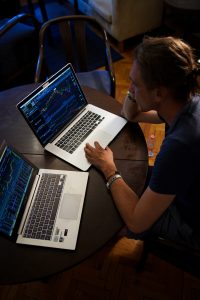Forex trading is one of the most lucrative investment opportunities that exist today. However, it can also be quite risky if you do not know how to calculate the potential risks involved in each trade. As a forex trader, it is important to be able to determine the level of risk involved in each trade, so that you can make informed decisions about your investments. In this article, we will discuss how to calculate risk with forex trading.
What is Risk in Forex Trading?
Risk in forex trading refers to the probability of losing your investment or making a profit. Forex trading is a highly volatile market, and the prices of currencies can fluctuate rapidly. Therefore, it is important to have a clear understanding of the risks involved in each trade before you invest your money. Calculating risk in forex trading involves determining the potential loss or profit that can be incurred from a trade.
How to Calculate Risk in Forex Trading?
To calculate risk in forex trading, you need to consider the following factors:
1. Lot Size
The lot size refers to the number of currency units that you are trading. The lot size can vary from broker to broker, but it usually ranges from 1,000 to 100,000 units of currency. The lot size you choose will have an impact on the amount of risk involved in the trade.
2. Stop Loss
A stop-loss order is a type of order that you can place with your broker to limit the amount of loss you can incur on a trade. When you place a stop-loss order, your broker will automatically close your trade when the currency price reaches a certain level. The stop-loss level you choose will also affect the amount of risk involved in the trade.
3. Currency Pair
The currency pair you choose to trade will also have an impact on the amount of risk involved. Some currency pairs are more volatile than others, and the price movements can be more unpredictable. Therefore, it is important to choose the currency pair that suits your trading style and risk tolerance.
4. Leverage
Leverage is a tool that allows you to trade with more money than you have in your account. This can increase the potential profits of a trade, but it can also increase the potential losses. The leverage you choose will have a direct impact on the amount of risk involved in the trade.
Once you have considered these factors, you can use the following formula to calculate the risk involved in a trade:
Risk = Lot Size x Stop Loss x (Price Difference / Pip Value)
Let’s break down this formula in more detail:
1. Lot Size
The lot size is the number of currency units you are trading. For example, if you are trading 10,000 units of a currency, your lot size would be 0.1.
2. Stop Loss
The stop-loss level is the price at which your trade will automatically close if the currency price reaches a certain level. For example, if you are trading a currency pair at $1.20, and you place a stop-loss order at $1.18, your stop-loss level would be 200 pips.
3. Price Difference
The price difference is the difference between the entry price of the trade and the stop-loss level. Using the example above, the price difference would be $0.02.
4. Pip Value
The pip value is the amount of money that one pip movement in a currency pair is worth. The pip value can vary depending on the currency pair and the lot size you are trading. For example, if you are trading 10,000 units of a currency pair with a pip value of $0.10, one pip movement would be worth $1.
Using the formula above, we can calculate the risk involved in a trade. Let’s say we are trading 10,000 units of a currency pair with a stop-loss level of 200 pips, and the pip value is $1. The risk involved in the trade would be:
Risk = 0.1 x 200 x ($0.02 / $1) = $0.40
This means that the potential loss in this trade is $0.40 if the stop-loss level is triggered.
Conclusion
Calculating risk in forex trading is an important skill that every trader should have. By understanding the factors that affect the level of risk in a trade and using the formula above, you can make informed decisions about your investments and manage your risk effectively. Remember that forex trading involves a high degree of risk, and it is important to use risk management tools such as stop-loss orders and proper lot sizing to minimize your losses and maximize your profits.





